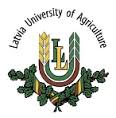Focal point
Location
The Latvia University of Agriculture (LLU) Strategic Development Plan 2010-2016, was developed during 2009 and approved by the LLU Senate on June 10, 2009.
In order to perform its functions and implement its goals and objectives, the Latvia University of Agriculture has developed three activity programs:
1. Studies
2. Science
3. Administrative and financial support for studies and research work
The goal of the Latvia University of Agriculture is to provide the possibility to obtain higher academic and higher professional education in agriculture, veterinary medicine, food technology, engineering, forestry science, social science, information technologies and environment management sectors as well as to develop science and to maintain and develop the Latvian intellectual potential and culture.
The objectives of the LLU:
To ensure the study quality corresponding with the standards of a national university what would allow to educate competitive specialists for the Latvian and international labor markets.
To develop the scientific potential to participate in international research, to integrate the academic education and research what would ensure introduction of innovative, knowledge - based technologies into the Latvian national economy, specially, in the Zemgale region.
To ensure sustainable development for the university as a national education, science and culture institution:
to strengthen the legal basis;
to improve the organizational structure in accordance
to the LLU objectives;to develop cooperation with institutions, academic education and science institutions in Latvia and abroad, enterprises and professional organizations and regional institutions of Zemgale;
to manage the LLU material and technical basis effectively.
The LLU mission
To develop the intellectual potential for sustainable future of Latvia and especially rural areas.
The LLU vision
To become a modern, internationally recognized and prestige university, taking part in the common European academic education and science space.
Members:
Resources
Displaying 1 - 5 of 152Influence of canopy height model methodology on determining abandoned agricultural areas
Determining areas affected by forest succession is one of the main tasks aimed at shaping rural areas. Effective determination of the parameters of the dynamics of forest succession in areas used for agriculture is the basis for understanding the phenomenon of land cultivation abandonment. Understanding it allows to implement a proper policy limiting the negative effects of giving up agricultural production. There are many methods to determine forested areas. The most popular group of the methods includes those that rely on the use of LiDAR data.
13th International Scientific Conference ''Students on Their Way to Science'': (undergraduate, graduate, post-graduate students): collection of abstracts, April 20, 2018 (Electronic resource)
The conference is aimed at dissemination of scientific research results, sharing of experience, improvement of foreign language and cross - cultural communication skills, and establishing of international contacts.
Use of remotely piloted aerial systems (R.P.A.S.) for wildlife monitoring
There are many methods to estimate wild ungulate populations. One of these is represented by observations from vantage points usually employed in medium-low covered forest areas to estimate cervids. This method is subject to some limitations, such as the risk of double counting and the necessity to a high number of operators due to the small size of the observable areas. Such limitations could be reduced by integrating the “vantage points method” with Remote Piloted Aircraft System (R.P.A.S.) surveys.
Risk factors of land degradation in management of state road infrastructure
Land is one of the most important natural resources; its use is determined by several factors, especially resources and infrastructure. Without proper land management and maintenance as well as after abandoning the land favourable conditions arise for land degradation. Land degradation processes are also found in road infrastructure, which are promoted by various risk factors.
Differences in spatial structure of rural areas of commune of Goraj with regard to size of farms owned by natural persons
Agriculture in Poland varies from region to region in terms of the level of farming culture and intensity of production. The majority of holdings are family farms, which use extensive farming practices and which are geared towards multidirectional production. They are characterized by low product marketability. Small farms with an area of 1-5 ha prevail. The largest fragmentation of individual farms is observed in the southern and south-eastern parts of the country. A more favourable agrarian structure is found in northern Poland.


